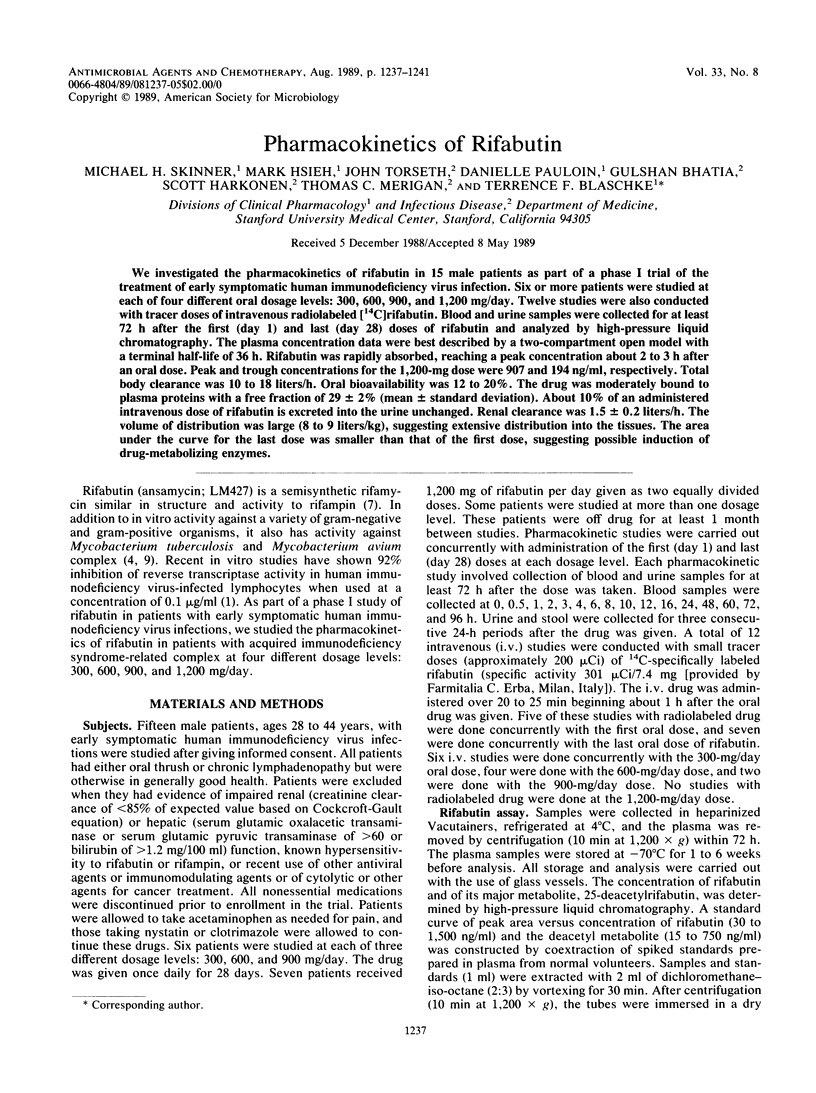Abstract
We investigated the pharmacokinetics of rifabutin in 15 male patients as part of a phase I trial of the treatment of early symptomatic human immunodeficiency virus infection. Six or more patients were studied at each of four different oral dosage levels: 300, 600, 900, and 1,200 mg/day. Twelve studies were also conducted with tracer doses of intravenous radiolabeled [14C]rifabutin. Blood and urine samples were collected for at least 72 h after the first (day 1) and last (day 28) doses of rifabutin and analyzed by high-pressure liquid chromatography. The plasma concentration data were best described by a two-compartment open model with a terminal half-life of 36 h. Rifabutin was rapidly absorbed, reaching a peak concentration about 2 to 3 h after an oral dose. Peak and trough concentrations for the 1,200-mg dose were 907 and 194 ng/ml, respectively. Total body clearance was 10 to 18 liters/h. Oral bioavailability was 12 to 20%. The drug was moderately bound to plasma proteins with a free fraction of 29 +/- 2% (mean +/- standard deviation). About 10% of an administered intravenous dose of rifabutin is excreted into the urine unchanged. Renal clearance was 1.5 +/- 0.2 liters/h. The volume of distribution was large (8 to 9 liters/kg), suggesting extensive distribution into the tissues. The area under the curve for the last dose was smaller than that of the first dose, suggesting possible induction of drug-metabolizing enzymes.
Full text
PDF




Selected References
These references are in PubMed. This may not be the complete list of references from this article.
- Anand R., Moore J., Feorino P., Curran J., Srinivasan A. Rifabutine inhibits HTLV-III. Lancet. 1986 Jan 11;1(8472):97–98. doi: 10.1016/s0140-6736(86)90747-6. [DOI] [PubMed] [Google Scholar]
- Benet L. Z., Galeazzi R. L. Noncompartmental determination of the steady-state volume of distribution. J Pharm Sci. 1979 Aug;68(8):1071–1074. doi: 10.1002/jps.2600680845. [DOI] [PubMed] [Google Scholar]
- Buniva G., Pagani V., Carozzi A. Bioavailability of rifampicin capsules. Int J Clin Pharmacol Ther Toxicol. 1983 Aug;21(8):404–409. [PubMed] [Google Scholar]
- Della Bruna C., Schioppacassi G., Ungheri D., Jabès D., Morvillo E., Sanfilippo A. LM 427, a new spiropiperidylrifamycin: in vitro and in vivo studies. J Antibiot (Tokyo) 1983 Nov;36(11):1502–1506. doi: 10.7164/antibiotics.36.1502. [DOI] [PubMed] [Google Scholar]
- Knott G. D. Mlab--a mathematical modeling tool. Comput Programs Biomed. 1979 Dec;10(3):271–280. doi: 10.1016/0010-468x(79)90075-8. [DOI] [PubMed] [Google Scholar]
- Loos U., Musch E., Jensen J. C., Mikus G., Schwabe H. K., Eichelbaum M. Pharmacokinetics of oral and intravenous rifampicin during chronic administration. Klin Wochenschr. 1985 Dec 2;63(23):1205–1211. doi: 10.1007/BF01733779. [DOI] [PubMed] [Google Scholar]
- Marsili L., Pasqualucci C. R., Vigevani A., Gioia B., Schioppacassi G., Oronzo G. New rifamycins modified at positions 3 and 4. Synthesis, structure and biological evaluation. J Antibiot (Tokyo) 1981 Aug;34(8):1033–1038. doi: 10.7164/antibiotics.34.1033. [DOI] [PubMed] [Google Scholar]
- Torseth J., Bhatia G., Harkonen S., Child C., Skinner M., Robinson W. S., Blaschke T. F., Merigan T. C. Evaluation of the antiviral effect of rifabutin in AIDS-related complex. J Infect Dis. 1989 Jun;159(6):1115–1118. doi: 10.1093/infdis/159.6.1115. [DOI] [PubMed] [Google Scholar]
- Woodley C. L., Kilburn J. O. In vitro susceptibility of Mycobacterium avium complex and Mycobacterium tuberculosis strains to a spiro-piperidyl rifamycin. Am Rev Respir Dis. 1982 Sep;126(3):586–587. doi: 10.1164/arrd.1982.126.3.586. [DOI] [PubMed] [Google Scholar]


